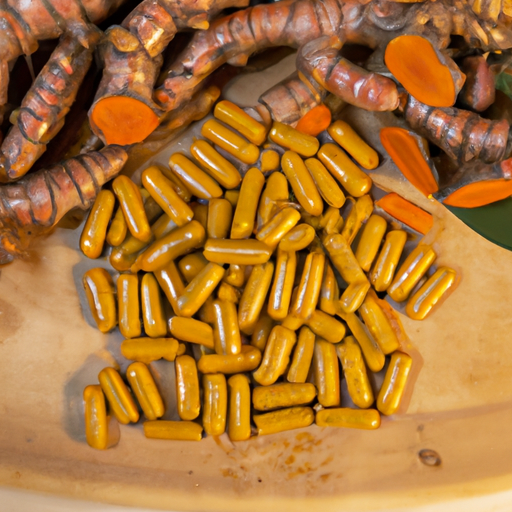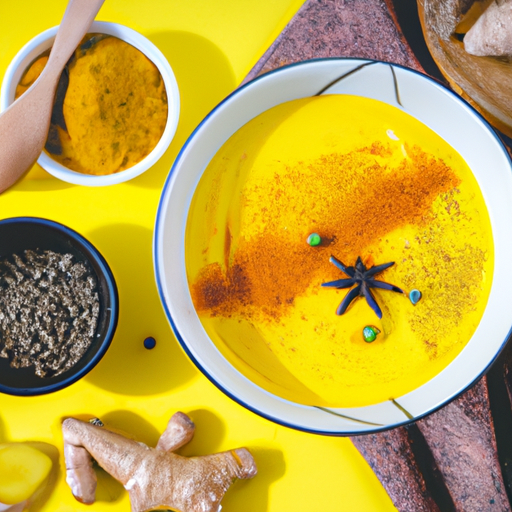I enjoy beginning my day with a comforting and delicious cup of turmeric tea, which also offers numerous health benefits.
Turmeric is known for its anti-inflammatory and antioxidant properties, making it a popular spice in traditional medicine practices.
But how long should you boil turmeric tea? The answer depends on several factors, such as the type of turmeric you are using, your personal taste preferences, and the strength of your stove.
In this article, I will share some tips and tricks for making the perfect cup of boiled turmeric tea, as well as common mistakes to avoid.
So grab your favorite mug and let’s get started!
Key Takeaways
- Boiling time affects the strength of turmeric tea, with longer boiling times resulting in a stronger taste.
- The water to turmeric ratio differs for fresh and ground turmeric.
- Experimenting with different boiling durations and ratios can help find the perfect cup of turmeric tea.
- Overboiling turmeric tea can lead to a bitter aftertaste.
Benefits of Turmeric Tea
You’ll love the benefits of turmeric tea – it’s a warm, comforting drink that can help soothe inflammation and promote overall wellness. Turmeric tea is made from the root of the turmeric plant, which contains curcumin – a powerful antioxidant with anti-inflammatory properties.
Drinking turmeric tea regularly can improve digestion, boost immunity, and even reduce the risk of chronic diseases like cancer and Alzheimer’s. There are several varieties of turmeric tea available in the market today. Some popular options include ginger-turmeric tea, honey-turmeric tea, and lemon-turmeric tea.
You can also experiment with different recipes to find your favorite flavor combination. Just remember to use high-quality ingredients for maximum health benefits. Now let’s move on to discussing the type of turmeric you should be using for your tea!
Type of Turmeric
If you’re using fresh turmeric root, be sure to wash and peel it before adding it to your pot. There are several varieties of turmeric available in the market, but the most common ones are yellow, white, and black turmeric.
Yellow turmeric is the most popular variety and is widely used in cooking and as a natural remedy for various health issues. White turmeric has a milder flavor than yellow turmeric but is still commonly used in culinary dishes in Southeast Asia. Black turmeric has a unique aroma and taste and is mainly used for medicinal purposes.
Turmeric has been used in traditional medicine for centuries due to its anti-inflammatory properties. Apart from its health benefits, it also adds flavor and color to dishes like curries, soups, stews, rice dishes, teas, smoothies, and more.
While boiling time may vary depending on personal preference or recipe instructions, knowing which type of turmeric to use can make all the difference when preparing any dish that requires this spice.
In the next section about boiling time, I’ll explain how long you should boil your turmeric tea for optimal results without losing its beneficial properties.
Boiling Time
To ensure optimal infusion of turmeric’s anti-inflammatory properties, steeping time is crucial when preparing a flavorful and healthy beverage. When boiling turmeric tea, it’s important to pay attention to boiling techniques to achieve the desired intensity of flavor. The longer you boil turmeric tea, the stronger the taste becomes.
However, overboiling can also lead to a bitter aftertaste. As a general rule, it’s recommended to boil turmeric for 10-15 minutes before letting it steep for another 5-10 minutes. This will allow enough time for the water and spices to fully infuse while avoiding any unpleasant bitterness.
With this in mind, let’s move on to discussing the next important aspect of making turmeric tea – the water to turmeric ratio.
Water to Turmeric Ratio
When making turmeric tea, it’s important to get the water to turmeric ratio right.
As someone who enjoys this drink regularly, I’ve found that the ideal ratio differs depending on whether you’re using fresh or ground turmeric.
For fresh turmeric, a good rule of thumb is one inch of root per cup of water, whereas for ground turmeric, a teaspoon per cup works well.
Getting these ratios right ensures that your tea has the perfect balance of flavor and health benefits.
Ideal Ratio for Fresh Turmeric
For the perfect cup of fresh turmeric tea, you’ll want to use a ratio of one inch of fresh turmeric root for every two cups of water. This ensures that your tea is packed with all the amazing health benefits that turmeric has to offer.
Here are some tips to get the most out of your fresh turmeric tea:
- Use a sharp knife to peel and slice the turmeric root into thin pieces.
- Bring the water and turmeric to a boil in a small pot.
- Reduce heat to low and let it simmer for 15-20 minutes.
- Strain the tea through a fine mesh strainer or cheesecloth before serving.
Now, if you don’t have access to fresh turmeric, don’t worry! Ground turmeric can be used instead, but you’ll need a slightly different ratio than with fresh.
Ideal Ratio for Ground Turmeric
You can achieve a vibrant, golden color and warm aroma in your hot beverage by using just half a teaspoon of ground turmeric for every cup of water. This ratio is ideal for those who prefer using turmeric powder instead of fresh turmeric root. However, it’s important to note that the strength of the turmeric tea flavors may vary depending on the quality and freshness of the spice.
Using turmeric powder allows for easier preparation and quicker brewing time compared to fresh turmeric root. It also ensures consistent flavor and potency in every cup. To enhance the taste, you can add other spices like ginger or cinnamon.
With this ideal ratio, you can enjoy a deliciously spiced beverage that offers numerous health benefits.
Now, let’s discuss how to optimize stove strength for boiling your turmeric tea.
Stove Strength
Strong stove settings swiftly steep the turmeric tea. When boiling turmeric tea, adjusting the stove temperature is crucial to achieve the desired flavor and aroma. A high heat setting can quickly extract all the essential oils and nutrients of turmeric, resulting in a potent cup of tea. However, boiling duration for flavor plays a significant role in determining how strong or mild your turmeric tea will taste.
To help you understand better, here’s a table that shows how varying boil times affect the strength of your turmeric tea:
| Boiling Time | Tea Strength | Flavor Notes |
|---|---|---|
| 5 minutes or less | Mild | Subtle earthy notes with slight bitterness |
| 6-8 minutes | Medium | Stronger earthy notes with slightly bitter aftertaste |
| 9-12 minutes | Bold | Intense earthy notes with pronounced bitterness |
Personal taste preferences also play an important role in determining how long to boil turmeric tea. Some people prefer their tea to be milder while others prefer bolder flavors. Experimenting with different boiling durations and ratios can help you find your perfect cup of turmeric tea.
Personal Taste Preferences
When it comes to making tea, personal taste preferences are key. For me, I like my tea on the stronger side with a bold and rich flavor. However, others may prefer a milder taste that is more subtle and delicate. Sweeteners such as honey can also be added to balance out the bitterness of certain teas or enhance their natural sweetness.
Additionally, add-ins like lemon or milk can completely transform the flavor profile of a tea. Ultimately, experimenting with different combinations is the best way to find your perfect cup of tea.
Mild vs. Strong Flavor
If you want a milder flavor, it’s best to steep the turmeric tea for only a few minutes. This will give you a subtle taste of turmeric without overpowering the other flavors in your tea.
If you prefer a stronger taste, however, let it boil for at least 10 minutes. Boiling the turmeric longer brings out more of its natural oils and compounds, resulting in a more robust and intense flavor.
To achieve your desired strength of flavor, you should also consider different steeping techniques. Some people prefer to simmer their turmeric tea slowly over low heat, while others like to bring it to a rolling boil before letting it simmer for several minutes.
Experiment with different methods until you find what works best for you and your taste buds. With that said, adding sweeteners or add-ins can complement or enhance the flavor of your turmeric tea further!
Sweeteners and Add-ins
Believe it or not, there are ways to make your turmeric drink even more enjoyable with a little bit of sweetness or add-ins. If you prefer your beverage on the sweeter side, try adding honey or maple syrup to your turmeric tea. Not only do these natural sweeteners enhance the taste of your drink, but they also come with their own set of health benefits.
On the other hand, if you’re looking for an extra boost in nutrition and flavor, consider adding some ginger or cinnamon to your turmeric tea. Ginger has anti-inflammatory properties that complement those found in turmeric while cinnamon is known to help regulate blood sugar levels. However, it’s important to keep in mind that any additional ingredients may also come with potential risks and side effects.
Always consult with a healthcare professional before making any significant changes to your diet or consuming large amounts of certain herbs and spices.
Transitioning into the subsequent section about tips for making the perfect cup, it’s important to note that finding the right balance between sweeteners and add-ins can be crucial for creating a delicious and healthy turmeric drink.
Tips for Making the Perfect Cup
To achieve the perfect cup of turmeric tea, it’s essential to pay attention to the brewing time and water temperature. Tea brewing techniques play a significant role in bringing out the distinct flavors of turmeric tea.
You can brew your tea for about 10-15 minutes, depending on how strong you want it. Be careful not to over-brew as it may result in a bitter taste. Water temperature also plays a crucial role in brewing the perfect cup of turmeric tea.
Boil water and let it cool for two minutes before pouring it into your teapot with turmeric root or powder. This ensures that you get an ideal temperature that will help release all the nutrients and flavor from the turmeric.
With these tips, you can customize your cup of turmeric tea by adding honey, lemon juice or ginger depending on your preference. Now that you know how to make a perfect cup of turmeric tea, let’s look at some common mistakes to avoid when preparing this delicious beverage.
Common Mistakes to Avoid
One common mistake when brewing turmeric tea is not paying attention to the water temperature and brewing time. Over boiling the tea can result in a bitter taste, which can be unpleasant. It’s recommended to boil water first and then let it cool for around 2-3 minutes before adding turmeric powder or fresh turmeric root.
Moreover, another common mistake is using the wrong temperature when brewing turmeric tea. Turmeric powder should be brewed at a lower temperature (around 185°F) than fresh roots (around 208°F). To avoid this mistake, it’s best to use an instant-read thermometer or simply bring the water to a boil and let it sit for a few minutes before adding the turmeric.
By avoiding these mistakes, you will enjoy a delicious cup of freshly brewed turmeric tea.
Now that we’ve explored some common mistakes with brewing turmeric tea, let’s move on to other ways of enjoying this versatile spice in our daily lives.
Other Ways to Enjoy Turmeric
Now that we’ve talked about some common mistakes to avoid when making turmeric tea, let’s explore other ways to enjoy this versatile spice.
Turmeric can be used in a variety of recipes, adding flavor and health benefits to your meals. Here are three of my favorite turmeric recipes:
-
Golden Milk: This warm, comforting drink is perfect for chilly evenings. Simply heat up milk (dairy or plant-based) and stir in turmeric, cinnamon, ginger, honey, and black pepper. Sip slowly and feel the soothing effects on your body.
-
Turmeric Roasted Vegetables: Toss your favorite veggies with olive oil and turmeric before roasting them in the oven for a delicious side dish or meal prep option.
-
Turmeric Smoothie: Blend together frozen pineapple chunks, banana, coconut milk, ginger root, turmeric powder and a pinch of black pepper for a refreshing smoothie that will give you an energy boost.
In addition to these recipes, there are many other alternative uses for turmeric beyond drinking it as tea. You can add it to scrambled eggs or tofu scramble for breakfast; mix it into salad dressings or marinades; sprinkle it over popcorn; or even use it as a natural dye for fabrics! Experiment with different ways to incorporate this vibrant spice into your cooking and see how it can elevate both the flavor profile and nutritional value of your meals.
Frequently Asked Questions
What are the potential side effects of consuming turmeric tea?
I’ve found that turmeric tea can have potential side effects if consumed in high doses, such as upset stomach and diarrhea. However, it also has benefits for skin and hair health when consumed in moderation.
Can turmeric tea help with weight loss?
I’ve found that incorporating turmeric tea into my diet has been helpful for weight loss. There are many recipes available online, but I like to mix turmeric with ginger and lemon for a refreshing drink that also aids digestion.
How long does brewed turmeric tea last in the fridge?
I’ve found that brewed turmeric tea lasts up to five days in the fridge if stored properly. To ensure maximum shelf life, use an airtight container and keep it away from light and heat.
Are there any medical conditions that turmeric tea should be avoided with?
Turmeric tea has potential drug interactions and should be avoided by those on blood thinners or with gallbladder issues. Pregnant women should also avoid excessive consumption. Always consult with a healthcare provider before consuming turmeric tea.
Can turmeric tea be consumed on an empty stomach?
Starting the day with a warm mug of turmeric tea on an empty stomach can provide numerous benefits. However, it’s important to stick to the recommended dosage to avoid any negative effects.
Conclusion
Well folks, after all that talk about turmeric tea, I’m feeling pretty pumped to go boil up a batch right now. And you know what? I think I’ll let it boil for 17 minutes just to really get the full effect.
But seriously, the boiling time for your turmeric tea is really up to personal preference. Just remember to use quality turmeric, pay attention to your water-to-turmeric ratio, and don’t be afraid to experiment with different stove strengths and flavors.
If all else fails, there’s always other ways to enjoy the benefits of turmeric – like adding it into a delicious curry or smoothie.
Now if you’ll excuse me, my teapot is calling my name.










